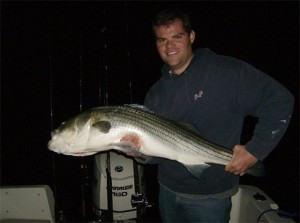Often time’s anglers become puzzled as to what bait or lure to use in a certain scenario. There exists today hundreds of different ways to catch a striped bass.
Bass can be caught by fishing with mackerel, pogies, squid and herring. Stripers are hooked by surface plugs, diving plugs, darters, shad bodies and jigs. Linesiders are trolled up by bunker spoons, umbrella rigs and swimming plugs. The list goes on and on.
All the above mentioned methods will catch bass. The problem is that not all of these methods always work. If an angler is casting a bulky surface plug, but the bass are honed in on small sand eels, he is more than likely out of luck.
The choice is then left to the fisherman to decide what bait or lure will work on a given trip. But is there one single method that will catch big bass all the time?
If there is, I am yet to discover it.
But by structuring a fishing trip around a single, proven “go-to” presentation, a fisherman can leave the docks with confidence, and easily eliminate half his tackle box.
Like many of you, I rely upon a $2 piece of surgical tubing to consistently put big bass in the boat.

The Tube and Worm
The tube and worm is no secret and for good reason. Tubes are inexpensive and can be easily made at home. Tubes catch inactive striped bass and also catch stripers that are actively feeding on baits that the tube does not imitate.
A tube will often work if bass are feeding on mackerel. A tube will also work if bass are feeding on sand eels. Obviously a tube will work if bass are feeding on two foot long worms. Which leads to the debate around what a tube and worm rig actually imitates.
I firmly believe striped bass mistake tube and worm rigs for ribbon worms and large sandworms which reside in our area, and can grow to a length of four feet. These worms are often reddish-pink or orange in color. Ribbon worms also swim through the water in a spiraling motion. Sandworms do more of a wiggle.
A 24 inch long ribbon worm, gyrating through the water, has an eerily similar resemblance to a properly trolled 24 inch long red tube.
If you are a striped bass accustomed to chasing speedy mackerel and ink filled squid, then catching a worm must be about as easy as it gets. It may be the human equivalent of hitting up the drive-thru over expending the energy necessary to prepare a turkey dinner.
In this sense, I think bass possess a “why not?” attitude towards tube n’ worms. I believe that even if bass are honed in on different bait, they will still eat a ribbon worm because it is so easy to capture.
Maximizing Time Spent On the Water
Enough time is spent on the water searching for fish, as discussed in Developing a Strategy for Finding Big Striped Bass and Tuna.
The last thing I want to do is waste time experimenting with different techniques and lure options when I finally locate an area holding big bass. Rare are the days that a tube n’ worm will not catch a fish, when trolled through productive areas.
This makes it easy to feel confident knowing that the tube will more than likely prove interesting to a passing striped bass, no matter the weather conditions or the presence of particular bait.
Trolling three different tube and worm rigs at three different depths through an area holding fish will quickly tell me what length/color tube and what depth will be most productive. Once a few fish are caught, I will have a pretty good sense as to the most productive tube and depth. A quick adjustment to the other two tubes is all that is needed.
Thus we have three proven fish producing tube and worm rigs, all fishing at the proven fish producing depth. It is a lot easier to consistently put big fish in the boat this way.
It is also much more fun experimenting with different methods after a few nice fish have been boated, such as utilizing light tackle.
Catch More Bass by Keeping Things Simple
There are endless theories bouncing around about what striped bass fishing techniques work best under certain conditions. I understand how easy it can be to get bogged down by the seemingly infinite supply of information on the web, in tackle shops, and in fishing books.
An important thing to remember when heading out on the water is to keep things as simple as possible.
Find the fish and give them something they want to bite.
If a specific technique consistently catches fish under a broad umbrella of variables, then consider making that technique your personal “go-to” presentation.” You will feel more confident knowing you are at least starting your fishing trip with a proven killer.
This year one of my go-to techniques will most definitely be trolling the tube and worm

